Before I had chickens I probably didn’t give a lot of thought to how eggs are actually made. That all changed post-chickens: it takes many months till those little chicks grow up and begin to lay, and in the interim there’s a lot of anticipation as to what kind of egg I’ll be surprised with in the nest box. For the most part, I breed crosses so there’s no predicting what colour I might find. Once I started looking into the actual logistics of what goes into making an egg I was blown away. It’s a small miracle that birds produce something so complex.
If you buy eggs from a store they are graded and those with imperfections aren’t sold. Once in a while you might see flaws in a farm egg, but most people just take eggs for granted.
Today we’re going to talk about egg oddities, but before we get into the weird stuff here’s a quick 101 on How An Egg Is Made:
Think of a hen’s reproductive tract as being like a conveyor belt with various components of egg production happening at different stations. The first part of the egg, the yolk, is made in the ovary and when it reaches the right size it’s released into the infundibulum. This is one end of a long, spiraling tube called the oviduct. If there is sperm present this is where fertilization takes place during a short window of opportunity before the egg moves on.
Next stop: the magnum, where the albumen (egg white) is added. As the egg goes down through the oviduct, it is continually rotating. Chalaza – strands made of tightly twisted albumen – form to keep the yolk in the middle of the egg and prevent it from sticking to the inside of the shell. There are two chalazae anchoring each yolk, on opposite ends of the egg.
It travels to the isthmus for the addition of shell membranes. The developing egg spends most of its time in the shell gland where the shell (calcium carbonate) and any shell pigments are added. As the egg is being assembled it travels down the oviduct small end first. In the vagina it is pushed out the large end first, preventing the egg from being contaminated by fecal material when it is laid. That whole process takes about a day. Since many hens lay several times a week the conveyor belt has a number of eggs, at different stages of development, at different stations along the way.
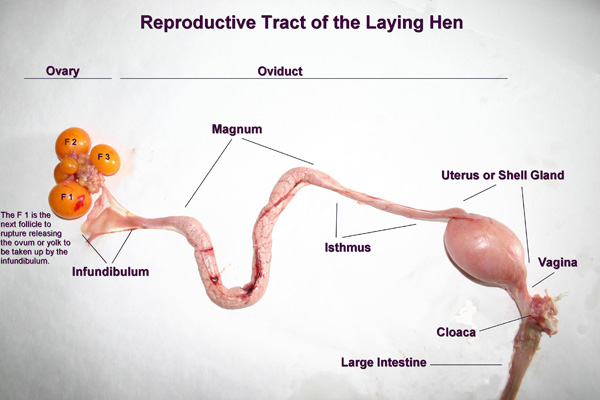
I have, over the years, had a few odd eggs but don’t have lots of photos so I put a call out to friends of Bitchin’ Chickens and was not disappointed with what I received.
Here’s a sample and the lowdown on some egg oddities:
Double yolks commonly occur in new layers when yolk release is mistimed and two yolks travel down the oviduct together. Older hens tend to lay larger eggs because the oviduct loses elasticity over time. A double-yolker rarely hatches. A triple-yolker is really rare.
Eggs with no shell feel rubbery because the membranes are on the outside. These irregular eggs are commonly produced by new layers, but can result at any time from stress or often from calcium, phosphorous or vitamin D deficiency.
This is a type of soft shelled egg called a tubular egg.

Tubular Egg (Bitchin’ Chickens) 
Tubular Egg (Bitchin’ Chickens)
High environmental temperatures are the most common cause of thin-shelled eggs. A hen’s increased rate of respiration interferes with calcium carbonate production and shell formation. Older hens generally produce thinner shells as their oviducts wears out.
Egg shells can have different textures caused by a number of factors: excess calcium (pimples that can be scraped off) or vitamin D intake to double-ovulation, disease, a defective shell gland or rapid changes in lighting (sandpaper shells).
Here’s one with the oddest calcium deposits I’ve ever seen.
When an egg is delayed in the shell gland, a second egg coming down the oviduct will bump into it and rest alongside the first egg, causing a flat, wrinkled side. These are called slab sided eggs.
Oddly coloured eggs are the result of being unevenly pigmented while in the shell gland pouch.
An egg within an egg occurs when, for some unknown reason, an egg almost ready to be laid reverses and backs up into the reproductive tract, where it meets the next egg in progress. The first egg receives more albumen, membranes and shell before being laid. The one in the middle is not only an egg-within-an-egg, but one received the blue pigment and the outer shell did not. The egg on the right is hard shell encased in a fluid filled soft shell.
Tiny eggs, sometimes containing no yolk, are referred to as fairy, wind, or fart eggs. (I don’t make this stuff up!) These irregular eggs are also common in new layers when the reproductive system is not yet synchronized, but can also occur in older hens when a piece of tissue from the oviduct breaks free, tricking the hen’s reproductive system into treating the tissue like a yolk and creating an egg.
Shells with slight cracks have been damaged while in the shell gland from stress or pressure. You can see how the cracks have been repaired before they were laid. Wrinkled eggs are often associated with respiratory infections, like bronchitis.
The first egg came from a hen that had infection which caused bleeding when she laid this ridged, over-calcified egg (which was normal on the inside). The result of that infection was scarring in the egg shell gland/uterus which has contributed to the uneven pigment of her subsequent eggs. The brown pigment is protoporphyrin, which is derived from hemoglobin and applied in the last few minutes in a hen’s egg shell gland. It should be deposited evenly; since her eggs are consistently unevenly pigmented the assumption is something has been damaged in her egg shell gland.
These ones usually occur while the hen is laying the egg, which then gets stuck, creating a little tail. Some of these are soft-shelled eggs which harden post-hatch.

In pullets, an immature shell gland can cause odd-shaped shells and is usually not problematic. In older hens, oddly shaped eggs can result from stress or, if they are a regular occurrence, a defective shell gland often caused by infectious bronchitis.
This is an interesting one laid by a hen who was previously egg bound. The soft-shelled egg on the right was followed by the ‘lash egg’ on the left. It’s not an egg but a by-product of a salpingitis infection.
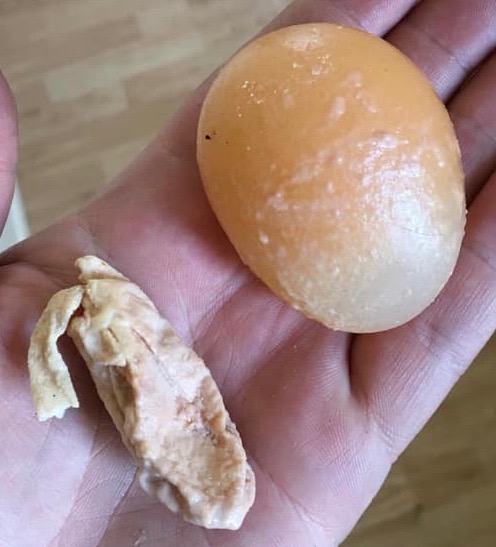
People see all kinds of religious imagery in clouds and on their morning toast, here’s Eeyore on an egg.
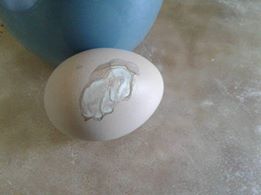
This appears to be an ovary follicle which got released early and bypassed the shell gland. The hen who laid it is fine (the owner not so much).

(Loren Alisa) 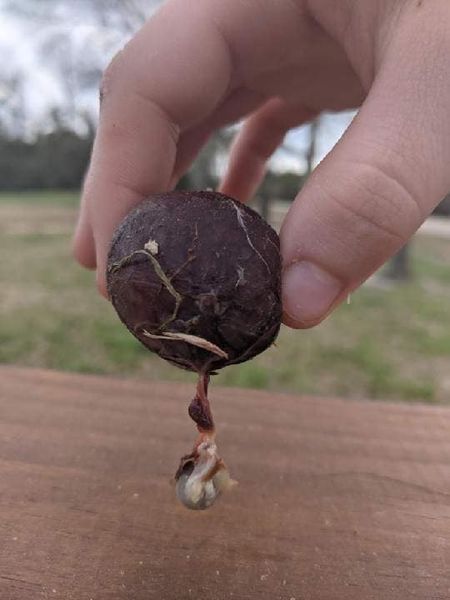
(Loren Alisa) 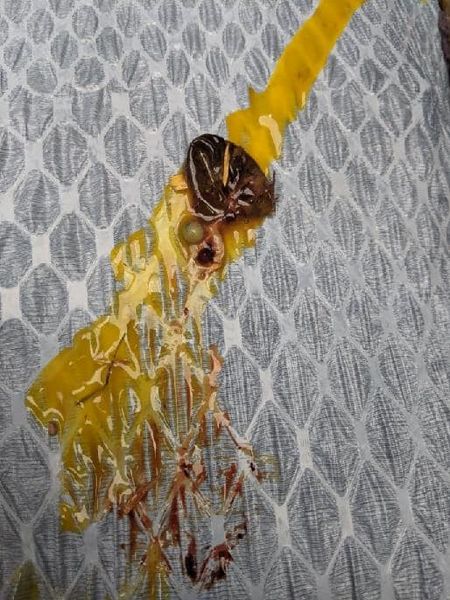
(Loren Alisa)
This is one of my favourites: One large egg when broken open revealed not just three yolks, but one tiny fart egg complete with shell!
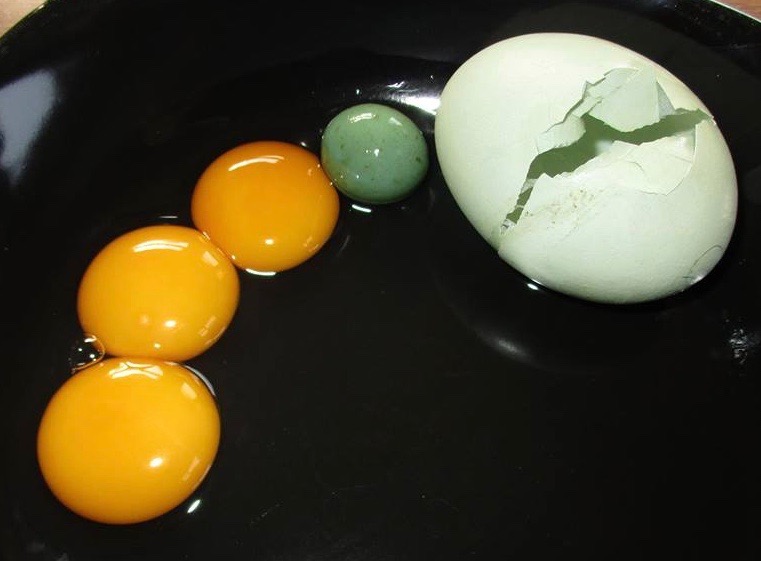
Occasionally I get some of these types of eggs, but you’re unlikely to see them. Usually only double-yolkers make the cut for quality control for you, my paying customer. We, the farmers, eat the oddities – the shells may be imperfect but those little orbs are perfect on the inside.
If you’ve got a weird egg and would like to add it to this post feel free to contact me with photos.
Photos courtesy of Bitchin’ Chicken friends: Agnes Laan, Angela Spooner, Audrey & Casey Boylan, Cas, Cheryl Handlen, Christie Miller, Connie Haslam Green, Courtney Kemp, Dawn McQuinn, Deanna Dunlop-Muise, Elizabeth Campbell, Janet Bost, Jenn Hobbs, Kathy Williams, Kay Ervin, Kimberly Brown, Laura Turner, Liza Jane, Loren Alisa, Marie Clark, Megan Hourd, Melissa Bodden, Minda Dimond, Rachel Leek, Reese MG, Shannon Briggs, Terra Strachan, Trent Biggs & Yvonne Mumblo.






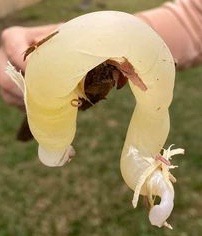


































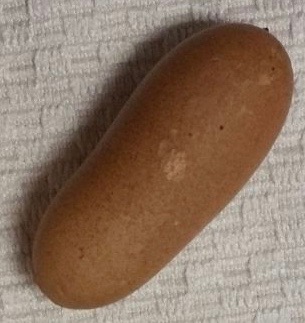



Great info & photos to prove that sometimes truth is stranger than fiction!
LikeLiked by 1 person
I’ve found plenty of strange eggs in my coop, and most of them have come from one of my three year old hens…Is that normal?
LikeLike
Yes. I think we’re trained by store-bought eggs to think of them as always being perfect, but there’s a real range of what is considered normal. As hens age there are changes in their reproductive systems (i.e. uptake of calcium, hormonal issues etc) that can affect the appearance of their eggs.
LikeLike
This is so interesting! Thank you and the folks you got the pictures from. I’ve had chickens for years and an always blown away by their antics, personalities and of course, the eggs.
LikeLiked by 1 person
Thanks for the read, very informative. I’m Trying to figure out what’s wrong with one of my hens. The last egg I got last year was 3 layers thick of calcium with rough ridges & was bloody. This spring I’m assuming the same hens bloom coating/pigmentation is really off & I’m wondering if something is wrong? But can’t figure it out. It doesn’t really match any of your examples. Wondered if I could send some pictures & get your thoughts?
LikeLiked by 1 person
Yes and I will add your photo to the post to see if anyone can help solve the mystery.
LikeLike
Today I went out this morning and noticed a hen limping, to prevent bullying and to give her rest I locked her in a cage I use when I need to separate a member from the flock for various reasons. This is a small pen and was perfectly clean and empty besides a pile of bedding. When I went to go check on her this afternoon she had laid and egg (no surprise she’s a good layer) and low and behold a second egg! The second egg however was shell-less. I didn’t know chickens could lay two in one day…or if this contributed to her limping problem in anyway. I have pictures of both eggs and that I found in the soft egg when I opened it (it was normal, not a lash egg) if anyone is interested in the pictures
LikeLiked by 1 person
It isn’t common for a hen to lay two eggs in one day, but clearly it happens. Feel free to send me some photos.
LikeLike
Please help. I love all my chickens but this one is a household favorite. She is a sapphire gem…about 19 weeks. She is a hyper producer. Almost all of her eggs have been double yolk. They are HUGE and at least every 24 to 26 hours. This two eggs attached has happened several times. Im am HOPING and praying this is just due to her rapid production and the hot hot weather we were having the last 2 weeks. It resembles the photo at the top of this page. I have pics too. Never been a fart egg…..always both have yolks and attached…almost like a human twin pregnancy when the two eggs split off from one another
LikeLiked by 1 person
I am assuming that she has just started laying recently. Pullets often go through a stage of laying ‘imperfect’ eggs: really small, double yolks, soft shells, no shells. The kind of eggs you are getting are a result of rapid ovulation or hormonal changes. She should settle down soon and hopefully lay smaller eggs because super-large ones put her at risk of reproductive tract issues.
LikeLike
She started laying right at 16 weeks. She had a couple in the first week that were odd. Then she had a perfect week exactly every 26 hrs….then the last week or so the Temps were reaching 90s and things got wonky. My kids would lose it if something happened to her
LikeLiked by 1 person
Heat stress has an impact on laying as well as her age. Let’s hope you get some cooler temperatures and things even out for her.
LikeLike
Thanks for this info . My buff Orpington lay an odd thumb shaped egg and a huge 3 yolk egg a few months ago and now I know why.
LikeLiked by 1 person
I had no idea there were so many types of weird eggs. Those fart eggs are so cute.
LikeLiked by 1 person
One of my pullets was puffed up in the run, and I realized she was going to lay an egg. I picked her up to carry her to the nest and put my hand under her backside. She plopped the egg right into my hand, but it was covered in yolk. The egg was otherwise normal. What is the condition that caused the yolk of, I presume, another yet-unformed egg to pass with the formed egg? The pullet had not been laying long when this happened.
LikeLiked by 1 person
I’ve had the same thing happen. Think of an egg developing as though it was on a lathe, slowly turning and adding the various components (i.e. yolk, albumin, membrane, shell, bloom) as it turns and makes it way through the oviduct. Occasionally, especially with new layers, glitches happen in the production line and steps get missed.
LikeLike
Thank you so much. My 1 year old hen laid a fart egg for no reason and I was trying to figure out what was going on.
LikeLiked by 1 person
Glad to have been able to have helped you solve the mystery.
LikeLike
This morning I found two soft shelled eggs inside the coop. I suspect they came from my 23 week old Aruacana. The one is broken but the other is still whole. Would it be wise to eat the whole one?
LikeLiked by 1 person
They are fine to eat.
LikeLike
Thank you. She laid a perfect blue egg yesterday, so it looks like the problem is solved.
LikeLiked by 1 person
I’m equal parts disgusted and fascinated.
I’m glad you put this info all in one place so we have something to refer to later. Thanks
LikeLiked by 1 person